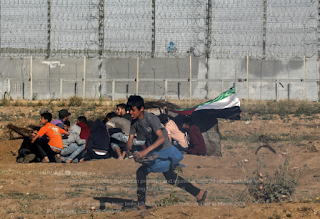On November 29, 1947, the United Nations General Assembly adopted a plan to divide Palestine into Jewish and Arab states. This plan, however, enabled the realization of the Zionist project for the establishment of the State of Israel.
This historic decision, six months later, led to Israel's creation on 14 May 1948, but the independent Palestinian state has yet to emerge.
Palestinian file in the custody of the United Nations
After the Second World War, Britain, which had been appointed by the League of Nations on Palestine since 1922, no longer controls the situation.
The Holocaust, the American intervention in the Middle East, the formation of the League of Arab States and the pressures of the secret Zionist groups have changed the situation on the domestic and international arenas.
In February 1947, London referred Palestine to the United Nations.
The vote took three minutes
On November 29, 1947, the United Nations General Assembly voted in favor of Resolution 181, which won the support of 33 countries, including the United States, the Soviet Union and France. 13 countries opposed it, including 10 abstentions, including Great Britain. The vote did not take more than three minutes.
Palestine, where 1.3 million Arabs and 600,000 Jews lived, was divided into three entities that should have become independent on 1 August 1948:
A Jewish state on 14,000 square kilometers and includes a strip extending from the northern Galilee finger to the shores of the Sea of Galilee and the Middle Coast from Haifa to Tel Aviv and the Negev desert. The partition gave the Palestinians three areas of 11,500 square kilometers, one in the Western Galilee and the other in the Gaza Strip, Border with Sinai, and the third in the West Bank.
Jerusalem and its surrounding towns formed an independent entity under a special international regime under the auspices of the United Nations.
Thus, the Jews received 54% of the land while they represented 30% of the population.
The plan provides for measures to be taken for independence in areas such as citizenship, the right of passage, the economic union and the declaration that each provisional government is to formulate for each of these proposed entities with regard to access to holy sites and the rights of religious communities and minorities.
The United States and the Soviet Union in a row
Britain, although it was the convenor of the special session of the General Assembly, refused to participate in the implementation of the plan. London, whose positions remained volatile, tended to support the Arabs. However, in view of the explosive nature of the issue, she chose to abstain.
France decided reluctantly to support the plan.
The Arab countries in the United Nations opposed until the end of the division the demand for the establishment of a single democratic and independent Palestinian state.
But it was confronted by an unexpected alliance in that period of the Cold War between the United States and the Soviet Union that secured the two-thirds majority needed to pass the resolution.
While the Soviets wanted to get Britain out of Palestine, the Americans supported the resolution because of their growing Jewish influence.
Dream and nightmare
Jewish Agency leaders agreed to the plan, but some Zionists rejected it because it is far from the Greater Israel they seek to establish. In Tel Aviv, the Jews held their breaths, but the crowds burst into joy after their adoption.
The Palestinians felt injustice and injustice. Arab countries rejected the plan.
Then the events in Palestine went on as each side sought to prevail.
On 14 May 1948, David Ben-Gurion proclaimed the establishment of the State of Israel immediately after the end of the British Mandate. The first Arab-Israeli war broke out the following day.
At the end of the conflict, Israel occupied 78% of the mandated territories of Palestine, while more than 760,000 Palestinians were forced to resort to neighboring countries or to the West Bank and Gaza.
In June 1967, the second war broke out during which Israel occupied the Syrian Golan Heights, the Sinai Peninsula, which was restored by Egypt in 1982, the West Bank as well as annexed East Jerusalem, and the Gaza Strip, which withdrew from it in 2005 after


 16:44
16:44
 Palestinian activist
Palestinian activist




















